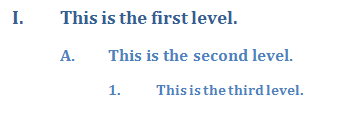Wordprocessing Numbering, Levels & Lists
The core definition of a numbering or leveling scheme is defining in an <w:abstractNum> element within the root <w:numbering> element of the numbering part (numbering.xml).
The above XML defines a leveling scheme with multiple levels (w:lvl) and an outline-like appearance as shown in the example below.
 |
Attributes:
There is just one attribute:
| Attribute | Description |
|---|---|
| abstractNumID | Specifies a unique number which will be used as the identifier for the numbering definition. The value is referenced by numbering instances (num) via the num's abstractNumId child element. <w:abstractNum w:abstractNumId="0">
. . .
</w:abstractNum>
<w:num w:numId="1">
<w:abstractNumId w:val="0"/>
</w:num>
|
Elements:
Below are the child elements, except for <w:tmpl> (related to where the definition can be displayed in the user interface), and nsid (related to tracking numbering definitions when documents are repurposed and changed).
| Element | Description |
|---|---|
| lvl | Specifies the properties of a particular level within the overall numbering definition. Note that a lvl can appear as part of the abstract definition (when placed within the <w:abstractNum>), or as an exception to the abstract definition (when placed within an <w:lvlOverride> of a <w:num> instance).
See Defining a Particular Level.
Reference: ECMA-376, 3rd Edition (June, 2011), Fundamentals and Markup Language Reference § 17.9.7.
|
| multiLevelType | Specifies the type of numbering defined--single level, multi-level, etc.: <w:multiLevelType w:val="multilevel"/>. This is only used by the word processing application to determine user interface behaviors and does not limit the list in any way. So, for example, a list marked as singleLevel will not be prevented from using levels 2 through 9.
It has just one attribute val with the following possible values:
Reference: ECMA-376, 3rd Edition (June, 2011), Fundamentals and Markup Language Reference § 17.9.13.
|
| name | Specifies a name for the abstract numbering definition. It is used to provide a user-friendly alias for a definition: <w:name w:val="Example Name"/>
Reference: ECMA-376, 3rd Edition (June, 2011), Fundamentals and Markup Language Reference § 17.9.14.
|
| numStyleLink | Specifies that the abstract numbering definition does not contain the actual numbering properties, but instead references the properties to be used by pointing to a numbering style in the styles part. A sample from a numbering part is below: <w:abstractNum w:abstractNumId="0">
<w:nsid w:val="099A081C"/>
<w:multiLevelType w:val="multilevel"/>
<w:numStyleLink w:val="TestNumberingStyle"/>
</w:abstractNum>
The corresponding style appears in the styles part as shown below: <w:style w:type="numbering" w:styleId="TestNumberingStyle">
. . .
</w:style>
Reference: ECMA-376, 3rd Edition (June, 2011), Fundamentals and Markup Language Reference § 17.9.22.
|
| styleLink | Specifies that the abstract numbering definition is the base numbering definition for the referenced numbering style in the styles part. (Since styling for the various levels of a numbering definition is specified in the abstract numbering definition via the pPr element, these styles can form the base for a numbering style in the styles part.) <w:numbering>
. . .
<w:abstractNum w:abstractNumId="5">
. . .
<w:styleLink w:val="ExampleNumberingStyle"/>
. . .
</w:abstractNum>
</w:numbering>
The referencing style appears in the styles part as shown below: <w:styles>
<w:style w:type="numbering" w:styleId="ExampleNumberingStyle">
<w:name w:val="ExampleNumberingStyle"/>
. . .
<w:pPr>
<w:numPr>
<w:numId w:val="6"/>
</w:numPr>
</w:pPr>
</w:style>
</w:styles>
There is a single attribute val. Reference: ECMA-376, 3rd Edition (June, 2011), Fundamentals and Markup Language Reference § 17.9.28.
|
